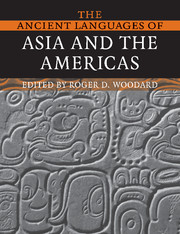Book contents
- Frontmatter
- Contents
- List of figures
- List of tables
- List of maps
- List of contributors
- Notes on numbering and cross-referencing
- List of abbreviations
- Preface
- Preface to the first edition
- 1 Language in ancient Asia and the Americas: an introduction
- 2 Sanskrit
- 3 Middle Indic
- 4 Old Tamil
- 5 Old Persian
- 6 Avestan
- 7 Pahlavi
- 8 Ancient Chinese
- 9 Mayan
- 10 Epi-Olmec
- Appendix 1 Reconstructed ancient languages
- Appendix 2 Full tables of contents from The Cambridge Encyclopedia of the World's Ancient Languages, and from the other volumes in the paperback series
- Index of general subjects
- Index of grammar and linguistics
- Index of languages
- Index of named linguistic laws and principles
Preface
Published online by Cambridge University Press: 01 September 2010
- Frontmatter
- Contents
- List of figures
- List of tables
- List of maps
- List of contributors
- Notes on numbering and cross-referencing
- List of abbreviations
- Preface
- Preface to the first edition
- 1 Language in ancient Asia and the Americas: an introduction
- 2 Sanskrit
- 3 Middle Indic
- 4 Old Tamil
- 5 Old Persian
- 6 Avestan
- 7 Pahlavi
- 8 Ancient Chinese
- 9 Mayan
- 10 Epi-Olmec
- Appendix 1 Reconstructed ancient languages
- Appendix 2 Full tables of contents from The Cambridge Encyclopedia of the World's Ancient Languages, and from the other volumes in the paperback series
- Index of general subjects
- Index of grammar and linguistics
- Index of languages
- Index of named linguistic laws and principles
Summary
Preliminary remarks
What makes a language ancient? The term conjures up images, often romantic, of archeologists feverishly copying hieroglyphs by torchlight in a freshly discovered burial chamber; of philologists dangling over a precipice in some remote corner of the earth, taking impressions of an inscription carved in a cliff-face; of a solitary scholar working far into the night, puzzling out some ancient secret, long forgotten by humankind, from a brittle-leafed manuscript or patina-encrusted tablet. The allure is undeniable, and the literary and film worlds have made full use of it.
An ancient language is indeed a thing of wonder – but so is every other language, all remarkable systems of conveying thoughts and ideas across time and space. And ancient languages, as far back as the very earliest attested, operate just like those to which the linguist has more immediate access, all with the same familiar elements – phonological, morphological, syntactic – and no perceptible vestiges of Neanderthal oddities. If there was a time when human language was characterized by features and strategies fundamentally unlike those we presently know, it was a time prior to the development of any attested or reconstructed language of antiquity. Perhaps, then, what makes an ancient language different is our awareness that it has outlived those for whom it was an intimate element of the psyche, not so unlike those rays of light now reaching our eyes that were emitted by their long-extinguished source when dinosaurs still roamed across the earth (or earlier) – both phantasms of energy flying to our senses from distant sources, long gone out.
- Type
- Chapter
- Information
- The Ancient Languages of Asia and the Americas , pp. xv - xviiiPublisher: Cambridge University PressPrint publication year: 2008

